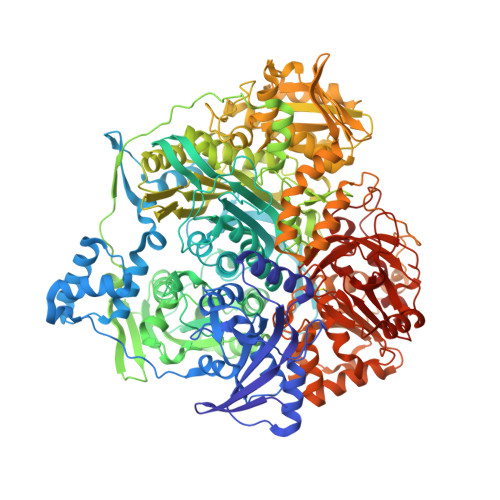Importance of hydrophobic cavities in allosteric regulation of formylglycinamide synthetase: insight from xenon trapping and statistical coupling analysis
Tanwar, A.S., Goyal, V.D., Choudhary, D., Panjikar, S., Anand, R.(2013) PLoS One 8: e77781-e77781
- PubMed: 24223728
- DOI: https://doi.org/10.1371/journal.pone.0077781
- Primary Citation of Related Structures:
4L78, 4LGY, 4MGH - PubMed Abstract:
Formylglycinamide ribonucleotide amidotransferase (FGAR-AT) is a 140 kDa bi-functional enzyme involved in a coupled reaction, where the glutaminase active site produces ammonia that is subsequently utilized to convert FGAR to its corresponding amidine in an ATP assisted fashion. The structure of FGAR-AT has been previously determined in an inactive state and the mechanism of activation remains largely unknown. In the current study, hydrophobic cavities were used as markers to identify regions involved in domain movements that facilitate catalytic coupling and subsequent activation of the enzyme. Three internal hydrophobic cavities were located by xenon trapping experiments on FGAR-AT crystals and further, these cavities were perturbed via site-directed mutagenesis. Biophysical characterization of the mutants demonstrated that two of these three voids are crucial for stability and function of the protein, although being ∼20 Å from the active centers. Interestingly, correlation analysis corroborated the experimental findings, and revealed that amino acids lining the functionally important cavities form correlated sets (co-evolving residues) that connect these regions to the amidotransferase active center. It was further proposed that the first cavity is transient and allows for breathing motion to occur and thereby serves as an allosteric hotspot. In contrast, the third cavity which lacks correlated residues was found to be highly plastic and accommodated steric congestion by local adjustment of the structure without affecting either stability or activity.
Organizational Affiliation:
Department of Chemistry, Indian Institute of Technology Bombay, Mumbai, India.





















